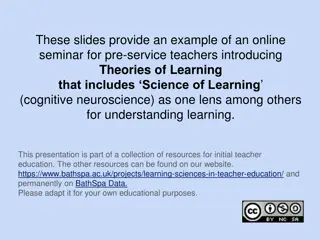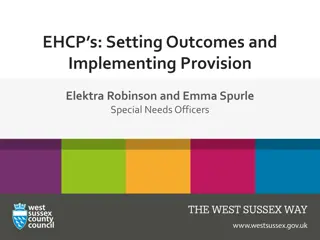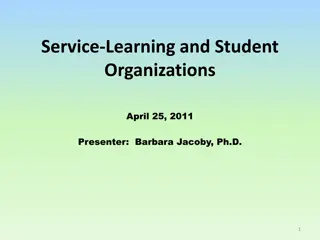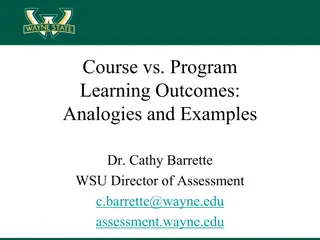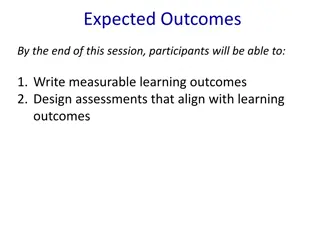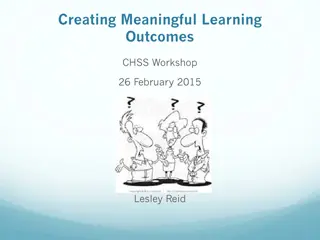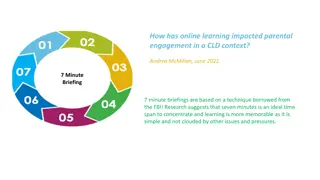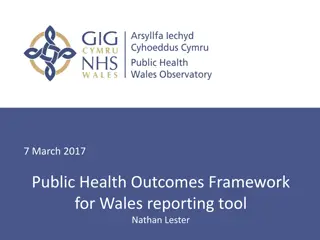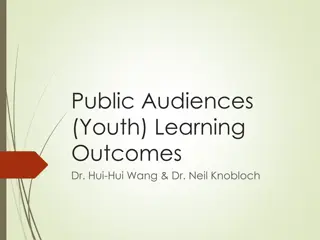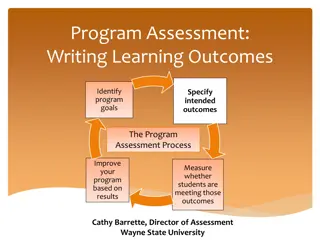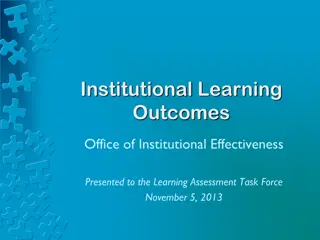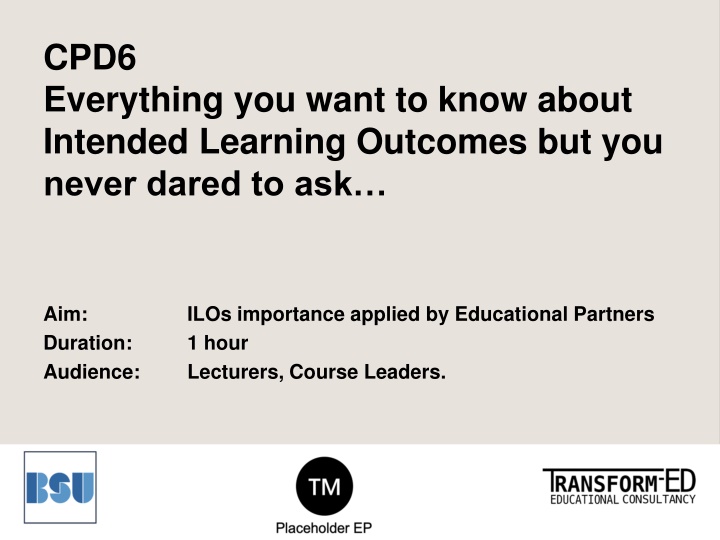
Mastering Intended Learning Outcomes: Comprehensive Guide
Dive into the realm of Intended Learning Outcomes (ILOs), understanding their significance, crafting effective ones, and aligning them with assessments. Enhance your ability to write clear, assessable ILOs and evaluate existing assessment methods for optimal educational outcomes.
Download Presentation

Please find below an Image/Link to download the presentation.
The content on the website is provided AS IS for your information and personal use only. It may not be sold, licensed, or shared on other websites without obtaining consent from the author. If you encounter any issues during the download, it is possible that the publisher has removed the file from their server.
You are allowed to download the files provided on this website for personal or commercial use, subject to the condition that they are used lawfully. All files are the property of their respective owners.
The content on the website is provided AS IS for your information and personal use only. It may not be sold, licensed, or shared on other websites without obtaining consent from the author.
E N D
Presentation Transcript
CPD6 Everything you want to know about Intended Learning Outcomes but you never dared to ask Aim: Duration: Audience: ILOs importance applied by Educational Partners 1 hour Lecturers, Course Leaders. Placeholder EP
Learning Outcomes By the end of this session, you should be able to: 1. Explain the nature and purpose of Intended Learning Outcomes (ILOs) at the level of programme, module and single teaching session. 2. Write effective ILOs by type and level, consistently with the culture of your discipline, and frameworks provided by the QAA and BSU. 3. Articulate the relationship between ILOs and assessment with the aim of evaluating existing module assessment(s) and devising new ones.
Content Defining Intended Learning Outcomes Related Terms Scholarship and Levels. Constructive Alignment: ILOs, Assessment and Students understanding.
Restricted - Other ILOs are A learning outcome is a statement of what a learner is expected to know, understand and be able to do at the end of a period of learning and of how that learning is to be demonstrated. Learning outcomes are linked to the relevant level and since they should generally be assessable they should be written in terms of how the learning is represented. Moon, J. (2002) The Module and Programme Development Handbook: A Practical Guide to Linking Levels, Learning Outcomes, and Assessment. London: Kogan Page, p.56.
Similar but not the same Outputs Aims Outcomes Tangible products (essay, artefact, portfolio) Material-focused General Intentions Teacher-focused Precise Measurable Student Focused
Example: Contemporary Dance 1 (Level 4) Aims: This module explores contemporary dance and aims to: foster an understanding of commercial dance techniques; engender a practical understanding of studio practice, class protocol, class etiquette. ILOs: By successful completion of the module, you will be able to: 1. Utilise the movement vocabulary, technical skills, and practices of contemporary dance techniques. 2. Comprehend the differences between contemporary dance techniques and release- based techniques 3. Identify and utilise professional studio practice classroom protocol, class etiquette. Outputs: Students will be able to present a video with a reflective piece of no more than 200 words.
Writing ILOs Clarity Jargon free Avoid ambiguous/general terms (e.g. the verbs know , understand ) Observability It should be possible to assess all learning outcomes Realistic Not too many Avoid lengthy (two-in-one) LOs Indicate a minimum standard
ILO Structure For example: Apply established techniques within forensic science research design, methodology and analysis. Subject Context Verb Forensic science, research design, methodology and analysis. Apply Established Techniques
Verbs to Avoid Demonstrate Demonstrate the ability to Understand [Multiple verbs in one ILO]
Make it yours (1) Consider a session you re delivering soon Create two appropriate learning outcomes
ILOs at Different Tiers 1. Programme 2. Stages/Levels 3. Module 4. Session 1 Programme 2 Stage/Level 3 Module 4 Session
Blooms Taxonomy Vanderbilt University
Institutional and national frameworks BSU Education Design Principles How to write Intended Learning Outcomes Office for Students https://www.officeforstudents.org.uk/publications/sector- recognised-standards/
Restricted - Other Constructive Alignment Learning and teaching activities Assessment methods Learning Outcomes (Designed to assess the learning outcomes) (Designed to meet the learning outcomes)
Make it yours (2) Aspect Interrogate Intended Learning Outcome It is understandable and applicable to your course, audience. Assessment The assignment reflect the ILOs and the marking criteria is clear for the students. Reflection Students are able to articulate the ILOs and their experience
Extra slide: Not so FAQ Do I really need ILOs? How can I translate ILOs for my students? Can we have non intended LO, how can we measure them? Is it possible to eliminate ILOs, what can replace them? If you need to do an Instagram reel or prepare a TikTok on ILOs, how would they look? Add yours
Summary ILOs are the backbone of Learning and Teaching, ensuring clarity and academic quality ILOs must be aligned with assessment and become clear for the students Check the ultimate guidance for ILOs here: https://www.bathspa.ac.uk/media/bathspaacuk/projects/teach ing-expertise-guide/Writing-ILOs-v2024-07.docx 17
Just One Thing Create a FAQ about Learning Outcomes for Lecturers and Students 18
Resources BSU Guide to Writing Intended Learning Outcomes, resources. ILOs and Higher Education, whys and hows Sheffield Hallam University What is SOLO Taxonomy? Bloom s Taxonomy and how to apply it, a guide from Imperial College 19





